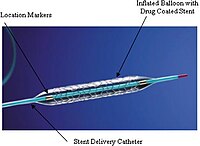
Photo from wikipedia
Aims: There is little evidence guiding the choice between a one-stent and a two-stent approach in unprotected distal left main coronary artery disease (UDLMCAD) presenting as acute coronary syndrome (ACS).… Click to show full abstract
Aims: There is little evidence guiding the choice between a one-stent and a two-stent approach in unprotected distal left main coronary artery disease (UDLMCAD) presenting as acute coronary syndrome (ACS). We aim to compare these two techniques in an unselected ACS group. Methods and results: We conducted a single center retrospective observational study, that included all patients with UDLMCAD and ACS undergoing PCI between 2014 and 2018. Group A underwent PCI with a one-stent technique (n = 41, 58.6%), Group B with a two-stent technique (n = 29, 41.4%). A total of 70 patients were included, with a median age of 63 years, including n = 12 (17.1%) with cardiogenic shock. There were no differences between Group A and B in terms of patient characteristics, including SYNTAX score (median 23). The 30-day mortality was 15.7% overall, and was lower in Group B (3.5% vs. 24.4%, p = 0.02). Mortality rate at 4 years was significantly lower in Group B (21.4% vs. 44%), also when adjusted in a multivariable regression model (HR 0.26, p = 0.01). Conclusions: In our study, patients with UDLMCAD and ACS undergoing PCI using a two-stent technique had lower early and midterm mortality compared to one-stent approach, even after adjusting for patient-related or angiographic factors.
Journal Title: Journal of Personalized Medicine
Year Published: 2023
Link to full text (if available)
Share on Social Media: Sign Up to like & get
recommendations!